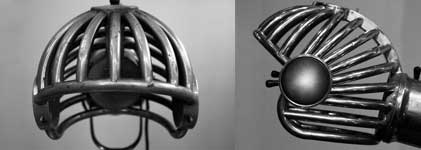This week, another reason to praise the Internet as writer Josh Friedman posts some of his Terminator work, how incoming students at the University of Chicago used an alternate reality game to ease into their life in college, and how you can use augmented reality to appreciate the imagination of David Bowie. But first, a look at a new indoor antenna for your television.
New indoor TV antenna uses cellphone technology to improve reception
On the long weekend I installed a new indoor TV antenna and gave it a try. The Smartenna+ from Channel Master (US$89).
I live in close proximity to where many of the local stations broadcast from, Seymour Mountain. Unfortunately, there’s a ridge between those towers and my house that blocks signals.
What makes the Smartenna+ different from other indoor antennas that capture television signals “over the air” is that it includes a processor that delivers “active steering” of the signals using a special processor. The effect is, Channel Master says, that the Smartenna+ can “eliminate over 90 percent of indoor reception issues that are commonly due to placement and movement.”
It’s also got a signal amplifier and comes with two coaxial cables (6 foot and 16 foot) with push-on connectors (which is more amazing than you might expect).
When I first set it up, it ran a scan of the room to determine where signal interference would be coming from.
Compared to other antennas that I’ve tried the Smartenna+ set up more quickly and delivered available signals better than any other, and I suspect it’s the new standard for indoor TV antennas. The device is $20 to $30 more expensive than other indoor antennas, though.
Writer Josh Friedman shares archive of The Sarah Connor Chronicles
Here’s yet another reason the interwebs are amazing. Writer Josh Friedman, who works in television and film, has posted a bunch of materials that were created while he was producing The Sarah Connor Chronicles (TSCC), a television show set in the universe of The Terminator, that ran for two seasons in 2008 and 2009.
That series was set a few years after the events of the second film, when John rescues his mother, Sarah, from an asylum and they seemingly put an end to the apocalyptic future in which computers become sentient and Skynet attempts to eliminate humanity.
With Lena Headey (now popular for playing Cersei Lannister in Game of Thrones) as Sarah Connor and Thomas Dekker as John, one of the unique aspects of TSCC was that one of the primary terminators is a teenage female, played by Summer Glau (from Firefly and Serenity fame).
Included in the materials Friedman has made available are a show bible (a document laying out the universe and characters to be used as a reference), a fictionalized interview Friedman wrote to pump the pilot before the show was picked up, and a plan for Season Two he created to secure a renewal.
Friedman’s brainstorming about what the show could be:
The Sarah Connor Chronicles show bible, written by Josh Friedman:
Synopsis of season two:
This alternate reality game is a better way to ease into university
Next month, many of the Grade 12 students in Canada will be writing exams and doing all the fun and tedious things that come with graduting from school. Those that are heading to university or college in September are already making plans, and one of the things they’ll be thinking about is how to get to know their new school.
The transition into post-secondary education is not always easy, and institutions have come up with programs to make it easier for incoming students. Depending on the school there are tours and seminars and workshops and clubs.
Last fall, the University of Chicago invited the more than 1,800 new students to play an alternate reality game they called The Parasite.
ARGs are set in the real world and are designed for groups of people to come together to play. They contain puzzles and role-playing, and require players to do math and find clues and search for answers.
As with earlier ARGs like The Beast and I Love Bees, these game experiences are notable for getting groups of people who may not even know each other to work together to achieve a common purpose.
With The Parasite the designers were intentionally trying to “make first-generation, low-income, queer, and otherwise marginalized students feel more accepted” by providing an environment to explore and become familiar with.
David Bowie’s style remembered in augmented reality
You can look at this New York Times website in a computer browser, but the experience won’t be the same.
Really, you want to use a smartphone equipped with augmented reality (AR) features, because that’s what makes it feel like what you’re seeing is in the room with you.
In this case, what you’ll see are some of the costumes that defined David Bowie and his various alter egos. The impetus is the traveling exhibit, David Bowie Is, conceived by the Victoria and Albert Museum in London, and which is at the Brooklyn Museum now. (The show was at the AGO in Toronto way back in 2013.)
Using my iPhone 8+, which is equipped with Apple’s ARKit, I was able to see iconic Bowie outfits in my kitchen, including the harlequin costume from Ashes to Ashes and the outrageous pantaloon jumpsuit from Aladdin Sane.
The New York Times also has an AR feature showing some of the U.S. athletes who were competing in the 2018 Olympic Winter Games.


Comments
Commenting is closed for this article.